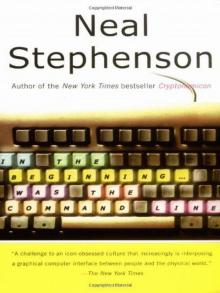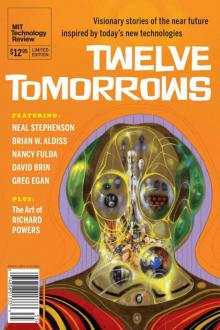- Home
- Neal Stephenson
Some Remarks: Essays and Other Writing
Some Remarks: Essays and Other Writing Read online
Some Remarks
Essays and Other Writing
Neal Stephenson
Contents
Introduction
Arsebestos (2012)
Slashdot Interview (2004)
Metaphysics in the Royal Society 1715–2010 (2012)
It’s All Geek to Me (2007)
Turn On, Tune In, Veg Out (2006)
Gresham College Lecture (2008)
Spew (1994)
In the Kingdom of Mao Bell (selected excerpts) (1994)
Under-Constable Proudfoot (2012)
Mother Earth, Mother Board (1996)
The Salon Interview (2004)
Blind Secularism (1993)
Time Magazine Article About Anathem (2012)
Everything and More Foreword (2003)
The Great Simoleon Caper (1995)
Locked In (2011)
Innovation Starvation (2011)
Why I Am a Bad Correspondent (1998)
About the Author
Also by Neal Stephenson
Permissions
Footnotes
Credits
Copyright
About the Publisher
Introduction
Certain persons who know what they are talking about where publishing is concerned have assured me that I have reached the stage in my life and career where it is not only possible, but advisable, to release a compilation of what are drolly referred to as my “shorter” works. You are reading its introduction, which I’ll try to make especially short.
Two general approaches could be taken to editing such a volume. One would be to make of it a pitilessly accurate historical record and trust the reader to make allowances for the widely varying levels of maturity, self-regard, and financial desperation that might have figured into the author’s motives while the component pieces were being produced. That might have been an interesting strategy twenty years ago, but now we have the Internet for that.
The second approach, of course, is to conduct a shameless whitewashing of that historical record, picking only the good stuff, and editing even that to make it look better. This, within reason, is what I have done here. Which is not to say that these pieces don’t contain material that might strike the sophisticated reader as dated or jejune; a bit of that has been left in because it makes me feel young. I have, however, removed some material that must have been topical when I wrote it but now seems merely inexplicable. As an example, the Slashdot interview, the second piece in the book, contains some answers that develop into essays that seem about as worth reading today as they ever were, while others were of interest only to that website’s clientele (lovely people, but they know how to find the original if they really want to reread it) eight years ago. The latter have been removed. I have made similar edits to some of the other stories.
As has been pointed out by some critics, writing short fiction is not my strong point, but I have published a small number of short stories in my day. Two of these, “Spew” and “The Great Simoleon Caper,” made the cut. A third, “Jipi and the Paranoid Chip,” seemed extraordinarily ponderous and labored upon rereading and so has been left out.
During the mid-1990s I produced two very long pieces of what might generously be defined as journalism for WIRED magazine. The second of these, “Mother Earth, Mother Board,” has not aged too badly and has been included intact. The first, “In the Kingdom of Mao Bell,” was not as good to begin with and has gotten worse since, as many of the remarks that, at the time, I thought of as insights have now either become bromides or simply been proven wrong. For all that, it does have a few decent anecdotal bits, and so what you will find in this volume is a heavily cut-down series of excerpts.
Finally, the book contains two original, previously unpublished pieces: an essay about sitting entitled “Arsebestos,” and a one-sentence work of fiction, unfinished, and, for very sound artistic and legal reasons, never to be finished, which I will allow the reader to discover in due course.
It only remains for me to thank the people who helped these pieces come into being: as always, my supernaturally patient and understanding wife, and my agent, Liz Darhansoff, who has been a fount of infallible advice for thirty years; Kevin Kelly at WIRED, who talked me past my initial skepticism that an article about cables could ever be any good and turned a blind eye to some rather odd expense reports; the readers/members of Slashdot; the Royal Society and Gresham College for inviting me to take part in forums where I would never have expected to find myself in any capacity above the level of bootblack; and the editorial page staff of the New York Times for randomly entering my life every few years and asking me to write short pieces on odd topics.
Arsebestos (2012)
As a boy, watching screen adaptations of Dickens’s A Christmas Carol, knowing nothing of Victorian England, I had only the vaguest understanding of what Bob Cratchit did for a living. Yet I sensed just how unpleasant his life was from the fact that he had to spend the whole day sitting on his bum. Scrooge, on the other hand, was generally depicted up on his feet, prowling through the countinghouse. Somehow, that was enough to tell a little boy in the 1960s everything about the class divide separating these two characters.
At about the same time, a few of my schoolmates began to show up occasionally in leather shoes, as opposed to sneakers. I sensed the beginning of a trend that would lead, in a few years’ time, to all of us wearing cramped, hard shoes, impossible to walk in, and imprisoned at desk jobs to the end of our days, supervised and sniped at by ambulatory Scrooges. I began to take inventory of careers in which it was allowable to stand up and walk around.
I have enough media savvy now to understand that the real-life Scrooges of the Victorian age probably spent at least as many hours on their arses as their Cratchits, and that the people who adapted the story for the screen were employing a visual shorthand: people who can move around have more freedom, hence higher status, than the deskbound. The metaphor is carried through faithfully to Tiny Tim, Cratchit’s son, who is the only person in Victorian London even less mobile than his dad. More mawkish screen adaptations of the story sometimes end with Tim, suddenly cured by Scrooge-subsidized medical care, spiking his crutch and doing a fandango around the Christmas tree.
The same shorthand is, of course, universal in film and television, where heroes stride and pace and run and dive. The deskbound are dweebs, losers, nebbishes. The class divide even extends to seating on airplanes. When the jet taxis to its gate and comes to a stop and the little ding sounds, the aisle-seat dwellers jump to their feet, claim space, and haul down their bags, while those stuck in the window seats can only crane their necks and meekly await permission to move.
All this was of merely abstract interest to me for a good number of years, until I found myself attending conferences and meetings with people who, unlike me, had not gone to irrational lengths to establish themselves in ambulatory careers. They racked up an amount of chair time that I simply could not believe was real. My ability to be of any use whatsoever in such contexts was limited strictly by how long I was able to remain on my arse: not very long, as it turned out.
Later, informed by health-care pros that years or even decades would be guillotined from my life expectancy if I didn’t spend a certain amount of time every week in aerobic exercise, I got into the habit of playing video games while pumping an elliptical trainer. This worked surprisingly well, but only kept my legs moving for forty-five minute stretches, a few times a week. During the rest of the time, my workday underwent a gradual and almost insensible transition that will sound familiar to anyone over the age of forty.
It used to be that reading the mail required walking to the
mailbox, slicing open envelopes, and other small but real physical exertions. Now we do it by twitching our fingers. Similar remarks could be made about talking on the phone (now replaced by Skype), filing or throwing away documents (now a matter of dragging icons around or, if that’s too strenuous, using command-key combinations), watching television (YouTube), and meeting with coworkers (videoconferencing). The portion of the day allocated to staring at pixels kept growing, and my physical movements were increasingly restricted to minute, repetitive movements of the finger and the hand. Wrist, shoulder, and back problems ensued. I spent a lot of money on fancy ergonomic chairs and keyboards. Each of them helped for a few months and then led to a new constellation of injuries. I’ve lost track of the number of times I’ve switched between mouse and trackball, left hand and right, trying to stay one step ahead of the pain. After a couple of decades of this, I finally got it through my skull that the problem wasn’t that I didn’t have just the right chair, keyboard, or pointing device; it was that I stayed in the same position all day long.
So more recently I obtained a treadmill specifically designed for use while working. For several hours a day I amble along at one to one point five miles per hour, clicking and typing and talking on the phone.
This is easy, by the way. I was worried that it would be difficult to type while walking. It isn’t, as long as your keyboard has a wrist rest.
I have not had any neck, shoulder, or arm trouble since I began doing this. I am convinced, though I can’t prove, that this is because I’m continually in motion and so whenever I click that mouse button or hit the “e” key on the keyboard, I’m doing it from a slightly different angle. According to the digital readout on the treadmill, I’m covering as much as four or five virtual miles per day and burning hundreds of calories.
Now my knee hurts a little, though. But more about that in a minute.
I switched to a treadmill desk because I hate sitting down and because I suspected it would help with my neck and shoulder troubles. Beyond that there was no particular rationale. But scientific research, released during the last couple of years, now reveals that sitting all day isn’t just a little bit unhealthy; it’s seriously and actively bad for you to an extent that goes beyond merely vindicating my childhood intuitions and is actually just a bit shocking. Or at least I’d be shocked if I were the legal department of a large corporation employing many people obliged to spend most of each day sitting on their bottoms. Ergonomic swivel chairs, it turns out, are the next asbestos.
Let us be clear about the import of this research. It’s not just that a bit of exercise is a good thing. It’s not the usual suggestion that deskbound office workers might want to spend a few minutes out of every hour on leisurely stretching exercises. What we have here is hard scientific data telling us that if you sit for any significant amount of time per day, it will kill you. Maybe with a heart attack, maybe with a stroke, maybe with cancer, maybe with diabetes. The reaper comes first for those who sit. In a society with a lot of coal miners, consumptives, and smokers, this might be drowned out in the statistical noise. Today it stands out like a siren on an empty road.
The bosses of the mid-twentieth century can’t be blamed. Sitting in a chair all day behind a desk: What could be safer, compared to the grueling factory, mining, and agricultural toil that took so many lives during the age of industrialization? They must have believed they were only doing the best for their employees. Actually they were setting in motion a slow-moving and mostly inadvertent Cratchitization of the workforce.
It sneaked up on us. The Cratchits of the 1950s could only spend so much time sitting before their typewriters. They still had to pivot in their chairs to reach a filing cabinet, take a telephone call, or communicate with a coworker. But because computers can now do everything, the only reason a worker now has to stand up is to use the bathroom; and if it were possible to get an app for that, we’d all download it. It’s a case of unfortunate timing, and unintended consequences: first, we all bought in to the idea that a normal job involved sitting in a chair, and then we found ourselves imprisoned by our own furniture and by the culture, expectations, employee manuals, and insurance policies built around them.
TWO KINDS OF COSTS ARE BEING INFLICTED BY THE NEARLY UNIVERSAL MISCONCEPTION that sitting in chairs all day is reasonable.
The first, already mentioned, is simply the long-term health effects of sitting.
The second, less obvious one is the opportunity cost caused by the fact that millions of otherwise smart and energetic people simply cannot bring themselves to spend much time in chairs, and therefore end up taking forms of employment that don’t really challenge their intellectual capacities, merely so that they can have the freedom, and, yes, the dignity to move.
Such people are frequently predisposed to think that they may have nothing to offer the modern economy because they may have done poorly in school. That people with dyslexia and ADHD are statistically overrepresented among physical trainers, building trades workers, and so on, may be noticeable to those who interact frequently with them. But even among those who don’t have those diagnosable conditions, I think that a good number are just fidgety boys who found themselves in a place called school where even during recess running was outlawed and knew, literally in their bones, that this was no place for them. We all know highly intelligent persons who failed to reach their potential because they simply could not find a place in the world of work. I put it to you that a considerable number of these just don’t like chairs. They walk into a modern office, with its grid of cubicles, and it morphs, in their mind’s eyes, into a classroom with its grid of desks, and they get itchy and want to turn around and run out into the fresh air.
I emphasize boys because the problem is so obvious and acute in their case, and statistics show that they are falling behind girls in educational achievement, college enrollment, and participation in the postgraduate workforce. Females, however, who face brutal strictures regarding how heavy they are allowed to be and what sorts of shoes they are expected to wear, obviously face their own set of issues around Cratchitization and may be more vulnerable to its effects simply because they don’t have as many options outside of the office-bound economy. A simple thought experiment: try to imagine Hope Solo spending forty years in a desk job. Or run the numbers and calculate the odds that a woman with a normal metabolism can spend forty hours a week sitting down (and, most likely, another ten hours a week commuting on her keister) and not gain weight.
DR. JAMES LEVINE OF THE MAYO CLINIC HAS EARNED A SORT OF MOSES-LIKE status among the growing community of “walk while you work” partisans. Sprinkled across the developed world, we trudge behind him at a stately pace of one to one and a half miles per hour as he leads us forth out of Aeronic bondage. His most recent opus, “Health-Chair Reform: Your Chair: Comfortable but Deadly,” is a small masterpiece of dry humor and hard data that would improve this essay considerably if I were allowed to quote it whole. A few nuggets:
“The articles in this issue of Diabetes . . . suggest that chair-living is lethal. Of concern is that for most people in the developed world, chair-living is the norm.”
“Modernity has imposed a Chair Sentence: work, home, and play are the shackles.”
“Sitting is not bad for you in moderation, but in excess it is addictive and harmful.”
“ . . . repeated frequent bouts of low-intensity meandering-style activity may be more health-beneficial than occasional bouts at the gym . . . a primary risk of ill health is sitting time per se.”
“There are solutions to chair-associated ill health that range from population-wide gym attendance, pharmacological administration, or genetic manipulation. Alternatively, people could get up.”
In the last of these quotes, Levine is referring, probably not with a straight face, to serious research suggesting that administration of pharmaceuticals could help boost people’s metabolic rates. Put the stuff in the water supply and everyone would get skinny. But it’s clear that
his heart is in the final sentence: “people could get up.” Levine has pioneered development of treadmills, desks, and other office furniture intended to support mobile office workers. His work has drawn the attention of a growing network of “office walkers” who use Internet forums to exchange tips, advice, product reviews, and, all too often, disheartening tales of how they tried to get a treadmill desk at work but got shot down by nervous higher-ups or rigidly conformist coworkers.
The most commonly cited reason for refusing to allow an office worker to swap chair for treadmill seems to be the perception that, if it caught on, it might increase the number of workman’s comp claims. Another justification heard with surprising frequency is that it just plain looks funny and somehow poses a distraction to coworkers. Some fear that the equipment will be noisy. Others wrongly assume that office walking is like what is seen in health clubs, where exercisers work up a sweat by pounding along at four or five miles an hour. People who just plain dislike the idea, and who are willing to grasp at any rhetorical straw to shoot it down, will complain about increased electricity usage or the weight of the device. All these objections are based on some combination of bad information, faulty logic, or outright disingenuousness. The kinds of treadmills designed for office use are no noisier than other office equipment; using mine in a quiet room I can participate in speakerphone conversations without anyone being the wiser. Their weight per square foot is no more than that of a normal human in an office chair (treadmill plus human has more weight than the human alone, of course, but it is spread out over a larger area). Walking at one to one and a half miles per hour is a completely different proposition from speed-walking in a health club; you amble along at about the rate of a coach-class traveler moving through an airport security queue, and breaking a sweat is unlikely.

 Zodiac: The Eco-Thriller
Zodiac: The Eco-Thriller The Mongoliad: Book One
The Mongoliad: Book One Snow Crash
Snow Crash The Confusion: Volume Two of the Baroque Cycle
The Confusion: Volume Two of the Baroque Cycle The Rise and Fall of D.O.D.O.
The Rise and Fall of D.O.D.O. The Diamond Age: Or, a Young Lady's Illustrated Primer
The Diamond Age: Or, a Young Lady's Illustrated Primer The Big U
The Big U The System of the World: Volume Three of the Baroque Cycle
The System of the World: Volume Three of the Baroque Cycle The Cobweb
The Cobweb Reamde
Reamde Fall; or, Dodge in Hell
Fall; or, Dodge in Hell Interface
Interface Quicksilver
Quicksilver The Mongoliad: Book Three
The Mongoliad: Book Three Seveneves
Seveneves Atmosphæra Incognita
Atmosphæra Incognita In the Beginning...Was the Command Line
In the Beginning...Was the Command Line Anathem
Anathem The Rise and Fall of D.O.D.O.: A Novel
The Rise and Fall of D.O.D.O.: A Novel The Mongoliad: Book Two
The Mongoliad: Book Two Diamond Age or a Young Lady's Illustrated Primer
Diamond Age or a Young Lady's Illustrated Primer THE System OF THE WORLD
THE System OF THE WORLD The Mongoliad: Book One tfs-1
The Mongoliad: Book One tfs-1 Some Remarks: Essays and Other Writing
Some Remarks: Essays and Other Writing Zodiac
Zodiac Spew
Spew The Baroque Cycle: Quicksilver, the Confusion, and the System of the World
The Baroque Cycle: Quicksilver, the Confusion, and the System of the World The Diamond Age
The Diamond Age Reamde: A Novel
Reamde: A Novel In the Kingdom of Mao Bell
In the Kingdom of Mao Bell Mother Earth Mother Board
Mother Earth Mother Board Twelve Tomorrows - Visionary stories of the near future inspired by today's technologies
Twelve Tomorrows - Visionary stories of the near future inspired by today's technologies The Confusion
The Confusion The Great Simoleon Caper
The Great Simoleon Caper The Mongoliad: Book Three tfs-3
The Mongoliad: Book Three tfs-3